 Royal Navy (24 built 1937-41)
Royal Navy (24 built 1937-41)J class: Jackal, Jaguar, Janus, Javelin, Jersey, Jervis, Juno, Jupiter
K class: Kandahar, Kashmir, Kelly, Kelvin, Khartoum, Kimberley, Kingston, Kipling
N class: Napier, Nepal, Nestor, Nizam, Noble, Nerissa, Nonpareil, Norman
WW2 British Destroyers:
V class | W class | W mod class | Shakespeare class (1917) | Scott class (1818) | A/B class (1926) | C/D class (1931) | E/F class (1933) | G/H class (1935) | I class (1936) | Tribal class (1937) | J/K/N class (1938) | L/M class (1940) | Hunt class DE (1939) | O/P class (1942) | Q/R class (1942) | S/T/U/V/W class (1942) | Z/ca class (1943) | Ch/Co/Cr class (1944) | Battle class (1945) | Weapon class (1945)The J, K and N class constituted a group of 24 destroyers built for the Royal Navy from 1938. Following the massive and coslty Tribal class, they were a return to a more “austere” design, smaller, with three twin mounts instead of four, but better balanced with a return to a two torpedo tubes banks. They were built in three flotillas characterized by letters assigned to their respective ships, naming these “J”, “K” and “N”. However the flotilla flagship received “G” names in 1940. Still, in design they marked a completely new departure after a design lineage that changes little since the 1920s and largely derived from the 1918 V-W class destroyers. The J-K-N were modified in wartime, bosleting their anti-aircraft (AA) artillery and getting better radars. They also saw heavy action with 13 ships sunk total, more than survivors (11), reflecting the high commitment in the Royal Navy and their frontline duties in the Atlantic, Mediterranean, Indian Ocean and Pacific.

Design of the class
Development
The J/K/N were intended as a follow-on from the preceding Tribal class, a revolutionary design that was every bit different from the usual destroyers built from the 1920s. The latter as said above were initially themselves a follow-up of the V and W classes of 1918-19, which took inspiration from destroyer leaders and ended as a much larger design compared to the ships made in 1914. They ended in a design that was not only influencial for the time, but was extrapolated for the A, B, C, D and evolutionary follow-up classes E, F, G, H, I. Apart the adoption of a new bridge for the latter, the formula was always the same: Four single mount main guns in superfiring positions A-B and X-Y, a “Pom-Pom” AA mount and two banks of three, then four torpedo tubes.
Abd then came the Tribals. Named after peoples (notabl warlike tribes) under the British Empire on all continents, their idea was coming from the realization that these “classic” designs were no longer up to the task against superior foes. The Italian Navigatori class and its six main guns for example, but more so the German Type 1934 and follow-up classes, or in the Pacific, also a concern for the RN, the “special type” (Fubuki) and their successors. They were all better armed and a bit faster in some cases, at least on paper. It seems the way forward for destroyer was now twin instead of single mounts, even if it imposed larger dimensions to keep stability overall, more power, and extra costs.
The idea with the Tribals in 1934-35 was to create “battle wagons” that could escort capital ships and aircraft carriers while engaging and surclassing enemy destroyers, both in raw firepower and accuracy. They needed superiority in gunnery more than in torpedoes, hence the solution of four twin mounts, for eight total and only a single quadruple torpedo tubes bank. This was completed by a slightly better AA, much better fire control and still ASW capabilities and mines if needed.
The Tribals answered that gap in capability and restored confidence in the RN that their destroyers would be up to the task, but they were also criticized as being very costly, at least 1.5 times more than standard destroyers, with a budget that remained limited, meaning less destroyers to come about and a mass of V-W vintage destroyers to replace, as they were close to their 20 years service limit.
This was a concerned already when the first “Tribal” keels were laid down in 1936. So the same year, the Admiralty looked for a way to still keep the advantage of twin mounts while having a return to a “standard” torpedo armament, in a cheaper package overall, and make for the numbers, replacing older designs. The decision to create with these two flotillas of 9 ships each, with one used as leader, led to planning a total 27 ships, which was reduced to 25 due to budget cuts (Only the J class had 9, but HMS Jubilant was cancelled in Dec.1937), and the K class had 8 ships.
Naming and Construction
At that stage, Bolton Eyres-Monsell 1st Viscount Monsell was 1st Lord of the admiralty from 1931 to 1936 and chose the names, with changes by Samuel Hoare in 1937 and Duff Cooper in 1938. They reflected trends of the time. Some were named after animals, others after writers or places, notably cities, and other after ancient names of RN ships back in the wooden and sail tradition.
The N class were ordered in 1940 as repeats of the J class, only because of delays and cost over-runs linked to the more complicated L and M class. The N class, which made for a 3rd flotilla of 8 ships, was manned by the Dutch Navy (2), five by RAN crews, and one by Polish Crews in wartime.
The only design change on the N class was to relocate the ‘X’ 4.7-inch mounting in an upper position to negate its 20° training blind spot forward. During construction, all the early wartime modifications of the Js and Ks were applied to them, notably two twin power-operated 0.5 in machine gun turrets on the quarterdeck and single 20 mm Oerlikons when available.
Yards:
Denny, Dumbarton: Jaguar, Kandahar, Noble, Nonpareil
Fairfield, Govan: Juno, Kelvin, Napier, Nestor
John Brown & Company, Clydebank: Jackal, Javelin, Nizam, Nerissa
Thornycroft, Woolston: Kashmir, Kimberley, Norman, Nepal
J. Samuel White, Cowes: Kingston
Swan Hunter, Wallsend: Karthoum
Yarrow & Company, Scotstoun: Kipling
Hull and general design
There were significant difference with thes news designs and the G-H-I class was well as the Tribals class. Notably unlike all previous Royal Navy destroyers, they had a two boiler room layout, reduced hull length, allowed for a single funnel, reducing the profile, increasing arcs of fire for the AA mounts. This was criticized however as adding vulnerability, two adjacent large compartments that could be now disabled by a single lucky hit and risk of total loss, which was verified in the war.
The practice was indeed earlier of having a three-boiler-room layout from the 1930s F class, succeeding to a traditional twin boiler rooms always one after the other. They were a great improvement over a single boiler room given their lack of protection and survivability. If fire control was not impressive back in the last war, by the late 1930s this was jo longert the case, and speed could just no longer be trusted to avoid being hit. Odds were now stacked against destroyers ad firepower grew in speed and accuracy in all navies. The chance of being hit just at the right spot, disabling both boiler rooms simultaneously however was considered “remote enough” and ruled out in exchange for its benefits. It enabled this “cheaper” alternative to the Tribals to be built at all.
On paper these ships had the exact same output as the Tribals, with smaller dimensions, resulting on trials speed up to 37 kts on light displacement, down to 33 on full load.
Naval architect Albert Percy Cole also had an important role in their design. He decided to dicth the traditional transverse frame sections he believed were unnecessarily strong, while they were held together by xomparatively weak longitudinals. Instead he decided the reverse, having extra strong longitudinals, weaker transverse frames. This also saved significant weight in the overall construction. He also decided for the bow design to retake the more angular stem of the preceding Tribal-class design, but not a (curved) clipper bow, rather a straight stem with increased sheer. This was not a success. In their early service, the ships appeared very wet forwards. This was corrected from the S class onward.
The compact boiler layout, despite its vulnerability was considered very successful for all th advantages it procured and became standard for all subsequent Royal Navy destroyer, from the O class up to the C class of 1943–1945. The armament as seen above was now “down” to three twin mounts instead of four but it was still comparable to IJN destroyers of their generation, both in gunnery and torpedoes with a return to two quintuple banks, this was two more, but having no reloads. AA was also not forgotten, and kept its increase inherited from the Tribals as well.
The J-K-N were “shortened Tribals”, they measured 103.5 meters between perpendicular and 356 ft 6 in (108.7 m) overall versus 377 ft (115 m) on the Tribals for a lesser beam at 35 ft 9 in (10.9 m) instead of 36 ft 6 in (11.13 m) which was a paradox given their twin boilers side by side. Draught was 12 ft 6 in (3.8 m) at deep load, versus 11 ft 3 in (3.43 m) on the Tribals, and it went further in wartime to 4,22 m and later 4,34 m. Their freeboard was slightly decreased and the prow has a peculiar forward deck rise. The poop was still rounded. The crew amounted to 183 officers and ratings, but could be augmented up to 218 in wartime and as flagships. The J-K-N displaced 1760 tonnes standard, 1773 tonnes on the N class, and fully loaded 2,330 tonnes for the J-K and 2,384 tonnes for the N class, later in the war, it rose respectively to 2,540 and 2,555 tonnes.
Powerplant
Apart the position of the main boilers in a single compartment amidship, all the remainder was a copy-paste of the Tribals class machinery, marked by a larger output compared to all previous classes. It consisted of still the same two shafts arrangement, three-bladed props, driven by two Parsons geared steam turbines, fed in turn by the two Admiralty 3-drum boilers side by side (separated by a bulkhead) rated for 44,000 shp (33,000 kW). To reach the same output, instead of three boilers, they were of a new Admiralty (Yarrow) model, presumably, but detailed specs are not known. Performances, due to the smaller dimensions were on paper the same as the Tribals despite one less boiler. Nominally this was 36 knots (67 km/h; 41 mph).
In pre-war trials, on a light displacement Jackal reached 37.492 kn (69.435 km/h; 43.145 mph) on the Arran mile, in 60 fathoms (360 feet) 34.37 knots (63.65 km/h; 39.55 mph) deep.
Jupiter in 75 fathoms (450 feet) made 33.835 kn (62.662 km/h; 38.937 mph) light, and 33.045 kn (61.199 km/h; 38.028 mph) on deep displacement.
As for range, the J-K-N carried 464 tons of fuel oil, for a top range of 5500 nautical miles at 15 knots cruise speed.
Armament
The armament was largely based on that of the Tribals, but trading the aft twin QF 4.7-inch (120 mm) Mark XII (L/45) for an additional torpedo tubes bank. The aft structure was thus shortened. However the position of “X” mount on deck, good for stability, was criticized as having a poor arc of fire, especially when complementing the forward battery in some angles. These mountings were still “semi-dual purpose”, capable of 40° elevation, with a 340° of training for A and B forward.
‘X’ mounting also had a rather blind 20° arc across the stern and was unable to fire dead astern, so this was corrected with the N class as it was relocated atop the structure rather than on deck. The tubes were quintuple for the first time (single quadruple on the Tribals), making for a heavy load of ten 21-inch (533 mm) Mark IX torpedoes, but no reloads were carried.
AA armament remained the same as for the Tribals, with a quadruple QF 2-pounder (40 mm (1.6 in) Mark VIII pompom, two quadruple 0.5-inch (12.7 mm) Vickers Mark III HLGs. Early in the war, 20 mm Oerlikons were adopted and the N class also obtained them instead of Vickers HMGs.
The J-K-N in 1940 were criticized for their heavy close range AA armament with a fire control and limited speed and elevation making their main guns not that effective in longer range AA fire. In short they needed for some a more modern 3-in AA gun. No Bofors were installed but extra 20 mm AA in 1944-45. Speaking of fire control, their arrangements also differed from the Tribals.
-They lacked a dedicated high-angle (H/A) rangefinder director.
-Instead was installed a simpler, smaller 12 ft (3.7 m) rangefinder behind the nominally dual purpose Director Control Tower (DCT). This was done for reasons of cost and weight, and underlined again the return to a more torpedo-focused design. But this rangefinder was also of a new model, modified to control the main armament for A/A fire, becoming a new “3 man modified rangefinder”.
-The Fuze Keeping Clock HA Fire Control Computer was however also kept from the Tribals and proved very efficient, if not game changing for accuracy.
Overall, for a smaller package and way more torpedoes, trading just two main guns, the J-K-N were considered by many a superior, or at least a much better balanced design. Apart “emergency designs” that returned to a classic four single mounts arrangements, the J-K-N defined the new standard British destroyer until the end of WW2.
BL 4.7 inches/45 Mark XII
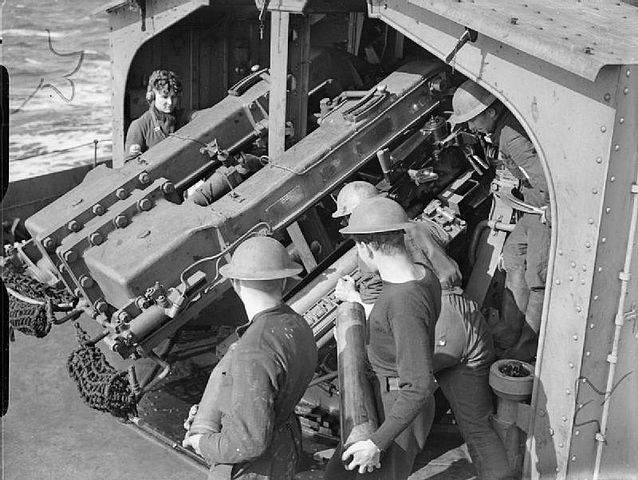
The Mark XII was closely related, apart its twin mounting to the now venerable Mark IX. The latter was used on many destroyers, from A through I class, O and Q through W destroyer classes as well as the ex-Brazilian (H class) and ex-Turkish (I class) destroyers, sloops and even submarines. It was a well proven design, for which tens of thousands of rounds had been manufactured and sent to depots across the Empire. So the Mark XII was only new because of its mounting, which prototype test destroyer was HMS Hereward. It was pioneered by the Tribals but also reused on the, J, K and N destroyer classes and the Abdiel class minelayers.
The Mark XII was generally similar to Mark IX except for its removable breech ring and that they had no register on the rear of A tube, and breech rings were machined to match. The later wartime sub-variant Mark XIIB had a loose barrel construction. They could be operated in either Quick Firing (QF) or Semi-Automatic (SA) mode. In the first, the breech was manually opened after firing, by moving a lever ejecting the spent casing, but in SA mode, it opened automatically and ejected the spent casing. When loading, the breech mechanism partially closed when the cartridge case rim hit the ejectors, fully close as the loading tray was raised. 372 Mark XII guns were manufactured. These guns used power ramming and power training and elevation, but no RPC gear.
The “turrets” were just an enlargement of the original gun shield to simplify production, the CPXIX mount itself weighted 25.09 tons (25.50 mt), to compare to 8.64 tons (8.79 lt) for an CPXIV single mount, so the superstructures and decks needed considerable bracing and strengthening unlike previous designs. It was powered elevated at 10 degrees per second, trained at the same speed, and had a shorter recoil of 18 in (45.7 cm). The CPXIX twin mounting were the first powered mounting specifically designed for destroyers, with a trunnion height 13″ (33 cm) higher than single mountings, which caused in turn to raise the wheelhouse even further with the same new bridge shape for the helmsman to see over the gun shields.
Loading at low elevations proved more difficult. The guns were solidary (same cradle) albeit still 38 in (96.5 cm) apart and firing with slight delay to reduce interference. But accuracy was poorer than the single mounts, albeit this was compensated by a better fire control. There were two dredger projectile hoists bringing shells from the shell rooms to the deck below the guns. “X” mounting aft was a deck lower, and thus, the hoists terminated on the upper deck. Shells were transferred via hand-operated sliding chutes, running diagonally between decks, and propellant cartridges passed up from the magazines to the guns by hand. To power these mounts a common 140 HP steam turbine and oil hydraulic pump setup was used. Elevation used an hydraulic motor driving pinions on a common shaft.
The Tribals as the J-K-N carried 150 rounds SAP and 30 rounds HE as well as 30 star shell per ship. Barrel life was approx. 1400 rounds. Read more on navweaps
Specifications Mark XII
Mass: 3.238 – 3.245 tons (3,290 – 3,297 kg)
Length: 224.08 in (5.692 m), Bore 212.6 in (5.400 m)
Shell: HE/SAP 50 lbs. (22.68 kg), 15 in (38 cm) long
Cartridge: Brass 4.724 x 30.922 in (120 x 785.42 mm)
Charge: 11.58 lbs. (5.25 kg) SC 109 or 13.13 lbs. (5.96 kg) NF/S 164-048
Full round with charge: 30.5 lbs. (13.8 kg) with propellant
Perfs CPXIX Mounting:2,650 fps (808 mps), RA 40° 17,000 yards (15,545 m), 10-12 rpm
Armour penetration wa 2.5″ (63 mm) of 90° stell armour from 6,500 yards (5,950 m) with the AP round.
CP Mk XIX
On HMS Nestor was installed the new type of twin mount replacing the Mark XII.
4-in(102mm)/45 QF Mk V
Installed on Napier, Nepal, Nestor and Nizam.
40mm/39 2pdr QF Mk VII/VIII

These ubiquitous AA gun was long derived from a Vickers WWI scaled-up 0.5 inches machine gun and eventually culminated with the Mark II in 1915. In 1923 was introduced the Mark VIII which became the new standard, characterized by its peculiar muzzle flash suppressor. This mount was located on the aft superstructure, in front of the aft mast, for a good arc of fire short of the obstruction of the funnels and bridge when firing at lower angles forward. When facing aft, it had to clear the projector platform and mast, reducing its usefulness mostly to port and starboard. It was also mounted on a powered bandstand.
Specifications pompom Mark VII
Calibre: 40 mm L/39
Shell Weight: 2 lb. (980 g) or 1.8 lb. (820 g) for High-Velocity (HV) round
Rate of Fire: 115 rpm fully automatic
Effective Range: 3,800 yards (3,475 m) or 5,000 yards (4,572 m) HV
Effective Ceiling (HV): 13,300 feet (3,960 m)
Muzzle Velocity: 2,040 ft/s (622 m/s) or 2400 ft/s (732 m/s) for HV
QF 0.5-inch/62 Vickers Mk III
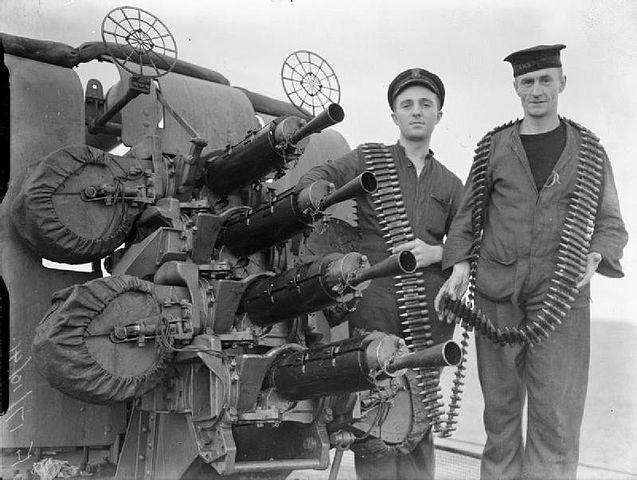
Two quadruple mounts for the QF 0.5-inch Vickers Mk III machine gun were installed on platforms between the funnels, one mount either side, like on the G-H-I class destroyers. They were poorly protected against strafing fire and of limited range, only having to offer a good volume of fire at close range. Between these and the limitations of the main guns, there was a critical inter-range gap remained uncovered, and this was paid dearly in WW2 albeit additions were made (see below).
The Mark III was a navalized land version in mountings of four tandem guns here, installed on the wings from 1931. This mount proved insufficiently powerful at short-range but from 1940-41 they were replaced on a per-mount basis by Oerlikon 20 mm cannon. This mount used a 200-round magazine per barrel, wrapping the ammunition belt around the magazine drum. 700 rpm (cyclic) or 450 for longer periods. The barrels could be setup for a spread 60 ft (18 m) wide, 50 ft (15 m) high at 1,000 yd (910 m). Vickers claimed 800 rounds in 20 seconds, reload in 30 seconds.
QF 0.5-inch specs
63 pounds (29 kg), excluding 10 pounds (4.5 kg) cooling water, 52.4 in (1.33 m) long, barrel 31 in (0.79 m)
Cartridge 12.7×81mm 0.5 inches (12.7 mm) mv 2,540 feet per second (770 m/s) ceiling 9,500 feet (2,900 m range 4,265 yards (3,900 m).
20 mm/70 Oerlikon Mk II/IV
Also, Nizam traded in 1945 her 2nd quintuple TT bank removed for a single 40mm/56 Bofors Mk III. She was the only one in the whole J-K-N class fitted with a Bofors gun.
21-inches torpedo tubes
The greater change made by the previous G-H-I was to go from triple (A-B, C-D), to quadruple (E-F class) quintuple torpedo tubes banks. The same types were installed on the Tribal class, a single mount which was reloadable thanks to cranes. The torpedo models depicted below are the ones most likely to be assigned:
Mark IX** (1935)
This standard model was designed from 1928, first appeared in 1930, and was considerably improved by 1939. Its best speed was 41 knots but at 35 knots, less than a Tribal at full speed.
Weight: 3,732 lbs. (1,693 kg). Neg. buoy. 732 lbs. (332 kg)
Length: 23 ft 10.5 in (7.277 m)
Explosive Charge: 805 lbs. (365 kg) Torpex
Range and Speed settings: 11,000 yards (10,050 m)/41 kts, 15,000 yards (13,700 m)/35 kts
Power: Burner-cycle, 264 hp @ 41 knots
The Mark X was introduced in late 1940 and perhaps installed, it was capable of 47 knots thanks to a wet-heater.
Mark XI(1944)
A British electric torpedo developed from 1942 and introduced from 1944. It was an attempt to copy the german G8e-T2 (captured) as a trackless topedo for submarines in the Mediterranean. None was delivered before the war ended, when the Tribals were scheduled to join the BPF, so they were never deplyoed but postwar for trials. More
Specs:
Weight 3,632 lbs. (1,647 kg), lenght 22 ft 5 in (6.833 m)
Negative Buoyancy: 734 lbs. (333 kg)
Explosive Charge; 710 lbs. (322 kg) TNT
Range and Speed, unique setting, 5,500 yards (5,000 m) at 28 knots, powered by Electric batteries.
Depth Charges
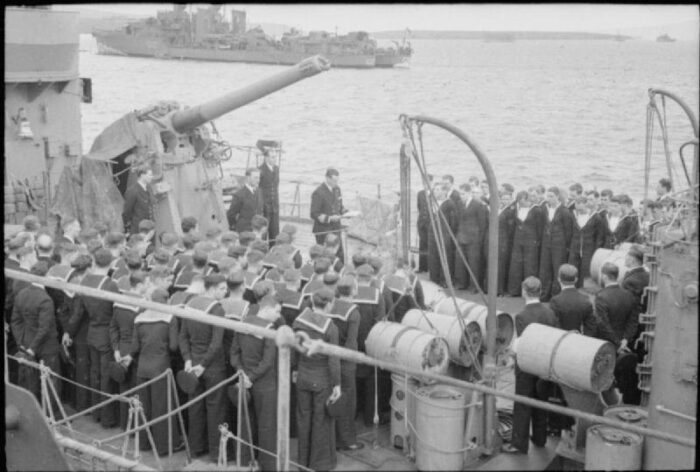
The usual set comprised two Mark II Depth Charges Throwers (DCT) aft on the poop deck, facing either side, and a single Depth Charge Rack (DCR) with 20 DCs at the stern. There were railings to the aft superstructure for a total storage of 40 more DCs. Reload was made by hand, using winches, always a dangerous task with a rolling deck washed by waves. These depth charges were of the standard British type, meaning it was the Mark VII: In entered service in 1939, weighted 420 lbs. (191 kg) and carried 290 lbs. (132 kg) TNT with a sink Rate or Terminal Velocity of 9.9 fps (3.0 mps) with a max setting at 300 feet (91 m) later 500 feet (182 m).
It’s possible they were later upgraded to the Mark X (1944) and the Mark X*. The X** was not introduced in service in 1945 despite its great depth (down to 1,500 feet (457 m)). Squid and Hedgehog made them obsolete. There are doubts also if the Mark VII Heavy studied from 1940 and proper to depth charge launchers were used aboard, outside experimentally. Weighting 420 lbs. (191 kg) with 290 lbs. (130 kg) TNT charge, they had a sink rate/terminal velocity of 16.8 fps (5.1 mps) and 300 feet (91 m) max setting, helped with 150 lbs. (68 kg) cast-iron weight attached. The idea was to reach the U-Boat faster, and it was claimed it could split open a 0.875 inch (22 mm) hull at 20 feet (6.1 m), or force to surface at 12 m or more. The game changer was a minol charge (1942) for better results, with a 30% increase.
Mines
J-K class destroyers could receive rails on the weather deck for minelaying operations. They also had an optional mechanical minesweeping gear. However it seems neither were ever mounted. The N class never provisioned any of these. If mounted, these would have been Mark XIV mines, a 1920s design with either 320 lbs. (145 kg) or 500 lbs. (227 kg) charge, and Hertz horns. Switch horns were installed and they became the Mark XVII.
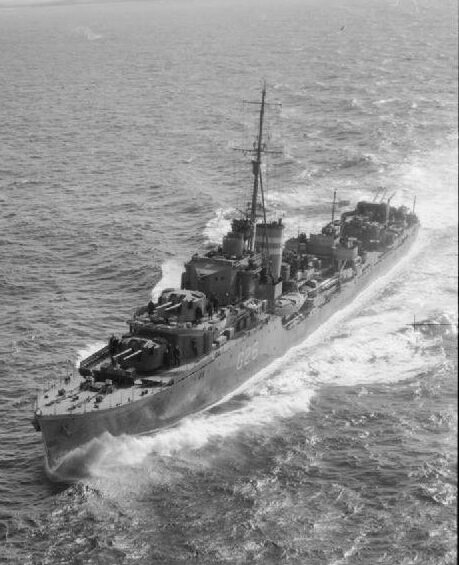
HMS Nepal underway, aerial view (AWM).
Sensors
Sonars
Type 124: From 1937, improved Type 121, range 2500 yards, 1st with chemical range recorder.
Type 144: From 1943, range 2500 yards (2300 meters) to 3000 yards (2700 meters), integrated into the fire control and coupled with Hedgehog. 1st with bearing recorder, automatic scanning, turning 5 degrees after each ping, often coupled with the Type 147 “Sword” depth finding sonar with a beam steerable vertically. Also coupled with the Q attachment reducing the under hull blind spot. 60° deep vertical beam, trained with the main Type 144 transducer.
When purchased by Canada, the four C-class destroyers were refitted on Canadian specifications and saw the Type 124 ASDIC installed, and steam heating probably fitted.
Fire Control
The J-K-N were the second class after the Tribals fitted with a Fuze Keeping Clock High Angle Fire Control Computer.
The Fuze Keeping Clock (FKC) was a simplified version of the High Angle Control System analogue fire control computer. The first model for destroyers was the FKC Mk.II in destroyers of the Tribal class. It was a non-tachymetric anti-aircraft fire control computer, capable of engaging targets at up to 250 knots (460 km/h; 290 mph).
It received vertical reference information from a Gyro Level Corrector, giving the aircraft’s altitude, range, direction, speed from the Rangefinder-Director. The guns received in turn on an indicator, their own correct elevation and deflection data relative to their position on the ship, and correct fuse timing to explode as close to the target as possible. A similar system was developed in the US for the 5-in/38 which later swapped only a more effective magnetic-proximity fuse. They had their Fuse Setting Pedestals or Fuse Setting Trays set on a clockwork mechanism within the AA shell warhead itself. In time, it was coupled with the Type 285 radar.
As for the rest, as seen above, they had a simplified A/A rangefinder, but of a new 3-man model.
Radars
Type 286:
Naval air search radar, first destroyer set, very crude, not rotating. Full data 286P: rotating antenna, better bearing accuracy of 3-5 degrees.
This was a metric target indication set, based upon RAF ASV Mark II set. The Type 286M had fixed antennas (central Tx and sides Rx) to indicate contact bearing. Fixed antenna so the entire ship needed to be aimed in the right scanning angle. The Type 286PQ had a steerable combined Tx/Rx antenna from the Type 291 set at least.
Napier, Nepal, Nizam, Nestor, Norman combined the type 285, type 286/P radars and type 124 sonar but Noble in 1946 received the type 291 and type 293 radars.
Type 271:
Small surface search radar using a standard microwave-frequency system with improved resolution to spot surfaced U-boat 3 miles (4.8 km) around, or a periscope at 900 yards (820 m). Full data
Type 285:
Anti-aircraft gunnery radar available from late 1940, Frq 600 MHz, power 25 kw, range 18,000 yd (16,000 m), ceiling 15,000 ft (4,600 m) accuracy 150 yd (140 m).
Modifications
In 1940 and 1941, it was decided to improve the anti-aircraft capabilities of all ships.
-Their aft torpedo tubes were removed, replaced with a single 4 inch gun QF Mark V on a HA Mark III mounting.
-The quad 0.5-inch HMGs were landed and replaced by a single 20 mm Oerlikon, with another pair added abreast the searchlight platform, amidships.
-The high-speed mine sweeps were landed and replaced by a rack and two throwers, for 45 depth charges
-A Type 286 Radar air warning was added at the masthead and a Type 285 fire control, on the H/A rangefinder-director.
In 1942:
-The 4-in QF Mark V gun was removed, torpedoes returned on all surviving ships until 1945.
-The 20 mm Oerlikons were replaced with twin ones except when on the quarterdeck.
-A Type 291 radar replaced the Type 286.
-Jervis, Kelvin, Nerissa and Norman had their searchlight replaced by a “lantern” centimetric target indication radar, Type 271.
-Javelin and Kimberley had a lighter Type 272 fitted at the truck of the foremast.
-Napier, Nizam and Norseman plus later Norman had the US SG1 Radar fitted at the head of a new lattice foremast
-Norman exploited her Type 271 set by a single 40 mm Bofors gun.
In 1945:
Surviving J/K ships carried a lattice mast and Type 293 target indication radar at the truck plus Type 291 air warning at the head.
Appearance
The J-K-N like the Tribals came out with the same basic medium gray livery, with parts of the deck in wood. As usual, the prow was coveted with steel with anti-sleep pattern plating and the poop also had a whole section covered in steel. Some ships had unit marks and bands on their single funnel, notably the flotilla leaders. Immatriculations were painted on the hull, generally in white, in the F and G ranges but also D when renamed by some K class ships. HMS Norman is a good example. Under RN supervision but with an Austrlian Crew, she was successfully G47, D16, and D149 from 1948 until BU in 1958.
As far as camouflage went, a few received interesting patterns, such as Javelin, Janus and jupiter.
PROFILES AWAITED
⚙ JKN specs 1939. |
|
| Displacement | 1,690 long tons standard, 2,330 long tons (2,370 t) deep load |
| Displacement (N) | 1,773 long tons (1,801 t) standard, 2,384 long tons (2,422 t) deep load |
| Dimensions | 356 ft 6 in x 35 ft 9 in x 12 ft 6 in (108.7 x 10.9 x 3.8 m) |
| Powerplant | 2 shafts, geared steam turbines, 3 Adm. 3-drum boilers: 44,000 shp (33,000 kW) |
| Top speed | 36 knots (67 km/h; 41 mph) |
| Range | 5,500 nmi (10,200 km; 6,300 mi) at 15 knots (28 km/h; 17 mph) |
| Armament | 1x 4 in, 4x 20 mm AA, 2×4 0.5 in AA, 2×4 21 in TTs, 1× DCR, 2× TCT, 20 DCs |
| Armament (N) | 3×2 4.7 in, 1×4 2-pdr pompom, 2×4 0.5 in AA, 1×4 21 in TTs, 1× DCR, 2× TCT, 20 DCs |
| Sensors | ASDIC, see notes |
| Crew | 183, 218 as Flotilla Leaders |
Assessment of the J-K-N classes
As the most modern and powerful British destroyers aside the Tribals when WW2 broke out, they were frontline, on all the most critical operations, spared nothing. Losses reflected this with 13 out of 24 commissioned, in tital six J, six K and one N class. The Mediterranean proved their most brutal theater, especially in 1941–1942, again reminding everybody that the Regia marina was no joke and this was the most demanding war front after France surrendered, unexpectedly leaving the RN fighting along the Italian navy, with later help from the Luftwaffe and Kriegsmarine. Like the Tribals, they had been designed as well with the Far East theater in mind and fighting the Japanese, which they did later in the war. The remainder were scrapped after the war, but there were exports. The Dutch vessels remained in service in long postwar years as Van Galen and Tjerk Hiddes, Poland retained Piorun until 1955, and Tjerk Hiddes was ultimately resold in 1951 to Indonesia and became Gadjah Mada, active until 1961.
Destroyer Leaders
 HMS Jervis
HMS Jervis
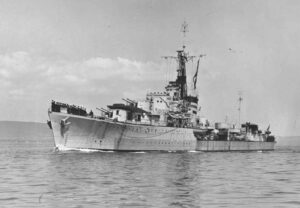 HMS Jervis was laid down at Hawthorn Leslie & Co. in Hebburn on 26 August 1937, lauched on 9 September 1938 and completed on 12 May 1939, a few months before the start of WW2. She became flotilla leader for the J-class, initially the 7th Destroyer Flotilla, so she was essentially similar to Kelly for the K class (8th Flotilla) as well as Napier for the N class.
HMS Jervis was laid down at Hawthorn Leslie & Co. in Hebburn on 26 August 1937, lauched on 9 September 1938 and completed on 12 May 1939, a few months before the start of WW2. She became flotilla leader for the J-class, initially the 7th Destroyer Flotilla, so she was essentially similar to Kelly for the K class (8th Flotilla) as well as Napier for the N class.
In September under command of Captain Philip Mack she was stationed with her unit in the Humber. Six months were occupied by sweeps across the North Sea, in which the unit went through storm and collisions. Jervis still captured three blockade runners. In March 1940 she collided with the Swedish freighter SS Tor and needed three months for repairs.
Captain Mack was moved to HMS Janus as flotilla leader, sent in May 1940 for the Mediterranean and the 14th DF. Jervis had a new pennant, G00 and by July she sailed to Malta, and resumed command. In 1941 she was present at the Battle of Cape Matapan: She took part in the destruction of Zara, crippled by battleships already when assisting the stranded cruiser Pola, after being hit earlier by an aerial torpedo. Jervis came alongside Pola, boarded her in the old sailing tradition, with pistol in hands. The wounded were evacuated and the remainder was taken POW and transferred on her and Nubian, which scuttled her. In April 1941, she led the action off Sfax. In May, she took part in the Battle of Crete, witnessing the loss of her leader sister Kelly. She ran night supply missions to Tobruk. In December she led her unit at the First Battle of Sirte. Back to Alexandria, she was damaged by an Italian human torpedo (Maiale) leaving her in drydock for six weeks.
By late January, she returned in operations, joining in April the Malta Strike Force, with Captain (D) A.L Poland, 14th FD for a year until 1943. By March 1942, she led her unit in the Second Battle of Sirte. On the night of 1/2 June, she preyed on an Italian convoy in the Battle of the Messina Convoy. Jervis was commanded then by Captain A.F Pugsley and was accompanied by the Greek destroyer Vasilissa Olga and screened by a Wellington bomber, dropping flares. The battle took one half an hour, resulting in the loss of the torpedo boat Castore.
Jervis also saw action at Operation Husky, the landings in Sicily, but also the landings on Calabria, Salerno, and Anzio, and Adriatic sweeps for German ships. She supported Yugoslav partisans as well. By the autumn of 1943, she sweeped the Aegean sea, and supported the failed offensive in the Dodecanese Islands. On 16/17 October with HMS Penn, she sank the submarine chaser UJ-2109 at Kalymnos.
On 23 January 1944 with HMS Janus, she saw an attack by a German Fritz X guided bomb. There was no casualties and she was able to reach Naples for repairs. On 28 January Captain Henderson took over command of the flotilla leader HMS Grenville. Lieutenant Commander Roger Hill became CO of the damaged Jervis in the meantime. She later steamed to Gibraltar and had a new bow installed. TShe sailed for home and saw action at the Normandy landings. She was eventually decommissioned in September 1944, given many new destroyers were entering service, she was worn out after extensive seervice and little maintenance, and damaged. She was paid off at Chatham and it was decided for a major refit until almost the end of the war. She was recommissioned when Germany surrendered in May. She wasn sent back to the Mediterranean, policed the aftermath of World War II and was paid off into reserve at Chatham, by May 1946. She was laid-up in the Gareloch and trained local Sea Cadets until stricken, placed on the Disposal List by October 1947, sand spent with explosives trials tests in Loch Striven, 1948. Still afloat she was given to the British Iron and Steel Corporation by January 1949, then Arnott Young at Troon, and BU from September.
“Lucky Jervis” had the reputation of a lucky ship seeing 5½ years of war, 13 major actions (as much battle honours), and she lost no crew. In particular at Anzio by January 1944, tasked for shore gunfire, like Janus she was attacked Henschel Hs 293 glider bombs and when Janus had her forward magazine exploding and sinking her with most of her crew, Jervis only lost her bow, without anybody around, and it was just mushed enough to allow her to proceed at 8 knots for repairs in Naples.
 HMS Kelly (1938)
HMS Kelly (1938)

HMS Kelly was laid down at Hawthorn Leslie and Co. in Hebburn on 26 August 1937, she was launched on 25 October 1938 and completed on 23 August 1939, a mere 11 days before the war broke out. She was named after Admiral of the Fleet Sir John Kelly. The Duke and Duchess of Windsor left France, where they were living for Britain on board. By the afternoon of 14 December she assisted the crippled tanker Atheltemplar on a german mine laid the previous night in the Tyne Estuary. HMS Mohawk escorted there with her the rescue tugs Great Emperor, Joffre and Langton, but Kelly also struck a mine. Joffre and Langton took the tanker under tow and Kelly herself by Great Emperor and arrived at the Tyne before midnight, assisted upriver by Robert Redhead and Washington and up to Hawthorn Leslie for three months patching.
In total contrast to the J class leader, HMS Jervis, Kelly was started to accumulate a rather unlucky reputation. She was just returned to active service as repairs were completed on 28 February 1940 when having a collision with HMS Gurkha on 2 March, for 8 weeks more in dry dock on the Thames, until 27 April, assisting with the Namsos operation.
In the night 9 May/10 May 1940, she was torpedoed amidships by the S-boat S 31 (Oberleutnant zur See Hermann Opdenhoff, Knight’s Cross). She was severely damaged, and taken under tow by the tug Great Emperor. But just four days underway she was attacked by E-boats and bombers and dodged all attacks, surviving by good seamanship of officers and of the teams tasked of preserving watertightness. Repaired at Hebburn shipyard, de-commissioned she returned to action by until December 1940. From the start of the war she just saw two weeks of active service and 14 months of repairs. She hosted Louis Mountbatten, Captain (D), frequently flying his flag on other ships of the 5th flotilla, notably HMS Javelin. Kelly returned to the 5th Flotilla and followed it to the Mediterranean, Malta from April 1941.
In April she joined for a special mission the minelayer Abdiel, the AA cruiser Dido, the destroyers Jackal, Jersey, Kashmir, Kelvin and Kipling at Gibraltar. “Force S” in Operation Salient started operations from Malta on the 28th and joined Force K to attack Axis shipping to North Africa. But on 8 May HMS Jersey struck a mine. She replaced her, escorting HMS Ajax, Dido, Orion and Perth to escort supply convoys to Egypt and Greece in Operation Tiger. On 10 May she led ther unit in a bombardment raid on Benghazi and back to Malta. On 21 May, she sailed to Crete with Kashmir and Kipling, and started patrolling north.
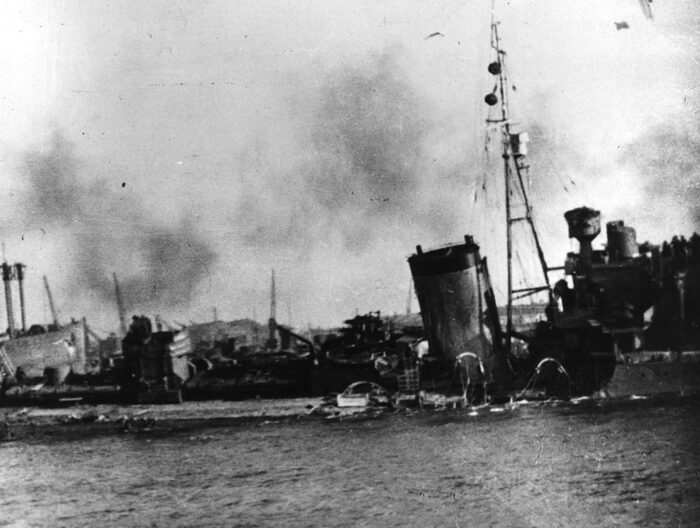
On 23 May, as the evacuation of Crete took place, the Luftwaffe showed itself particularly fearsome. Stukas in particular, helped by the clear skies and near perfect conditions leanred to drop their “egg” straight into a funnel. Kelly with her usual luck did not survived. She took a direct hit which blasted her, she sank in shallow waters, with half her crew killed when it happened. Kelly’s AA gunners however managed to shot down three Stukas, plus a fourth so badly mauled it crashed upon returning to base. The event left such an impression this led later to a movie commemorating Kelly in 1942 “In Which We Serve” starring Noël Coward and John Mills. Kelly was “HMS Torrin” but mimicked her career. Reunions and commemorations followed, from a newly formed association backed by Louis Mountbatten and supported notably by Charles III and Sir John Mills. In South Tyneside where she was built a public house was renamed “The Kelly” and she is depicted in artworks at the metro station.
 HMS Napier (1940)
HMS Napier (1940)
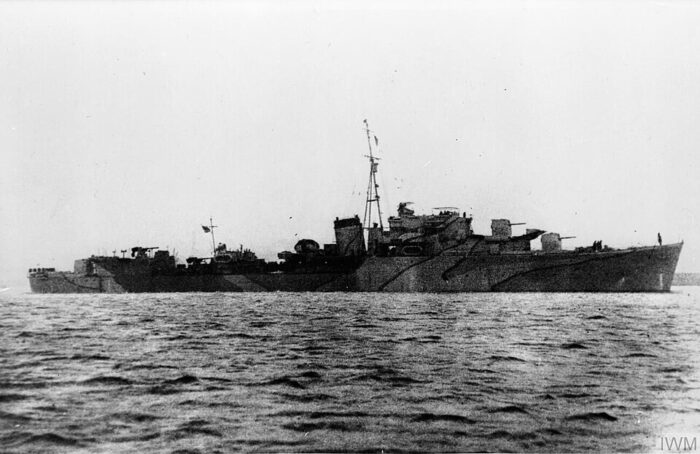
HMS Napier was the flotilla leader of the N class. She had been laid down at Fairfield on 26 July 1939, launched on 22 May 1940 and completed on 11 December 1940. She was named after the Scottish Admiral Sir Charles Napier, and her badge reproduced Napier’s family coat of arms. He cost was 403,960 pounds. Early in her service some sailors mutineed for a short while when they refused to leave their mess deck, defused with tact by the first lieutenant. By January 1941 she hosted Winston Churchill to Scapa Flow and Scrabster to follow Lord Halifax gone for the US as the new British Ambassador. It’s only after that napier completed her sea trials. She became a convoy escort in the North Atlantic and with Nestor was ordered to the Mediterranean, starting with the evacuation of Crete. Next she was sent to Port Said as control ship for the harbour’s defence, notably at night. By August, she took the lead of the 7th DF. She took part in Tobruk Ferry Service and escorted convoys notably to the Red Sea, or transferred troops between Cyprus and Haifa.
In early 1942, Napier, Nestor, Nizam were the first of their class transferred to the pretty meagre British Eastern Fleet. They had to escort a precious asset there, the HMS Indomitable to Malaya-Java. In June, Napier and Nestor were back to the Mediterranean and Operation Vigorous, supporting besieged Malta. Napier was then back to duties with the Eastern Fleet after an unsuccessful convoy run. By September she took part in Operation Ironclad, the Madagascar campaign, and was present for the surrender of Majunga and occupation of Tamatave. She started a cycle of patrols in the East Indian Ocean from October 1942 until March 1943. She was soon back with the Atlantic ASW force in South Africa. By early 1944, she returned to Indian waters and by late 1944, sailed to Australia for a station there after a long an well deserved overhaul at Williamstown. She returned to the Eastern Fleet by early November. In December, she supported operations of the 74th Indian Infantry Brigade and by January 1945, covered the landings at Akyab and Ramree.
By early 1945, HMS Napier returned to the British Pacific Fleet, and her pennant went from G97 to D13. In May, she escorted the largest British carrier air raids so far, on Sakishima. Napier had to honor to be present in Tokyo Bay, on 2 September 1945 and witnessing the Surrender. She also supported the occupation landings, and sailed to Sydney for a new refit. For her wartime career she earned six battle honours, including “Crete 1941”, “Libya 1941”, “Indian Ocean 1942–44”, “Burma 1944–45”, “Pacific 1945”, and “Okinawa 1945”. Less than Jarvis, but she saw more oceans and seas than the two other flotilla leaders for sure. She left Australian waters 25 October 1945, sailing for home. After a last refit she never recommissioned and placed in reserve for almost a decade. In 1954 she was stricken, and sold to Thos. W. Ward the net year to be broken up at Briton Ferry from January 1956.
J/K/N class Destroyers career
 HMS Jackal (1938)
HMS Jackal (1938)
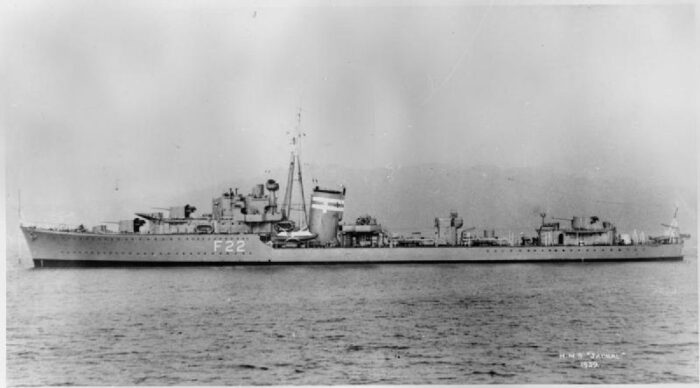
HMS Jackal was laid down at John Brown & Co, Clydebank, on 24 September 1937. She was launched on 25 October 1938 and commissioned on 31 March 1939. After commissioning and working up, Jackal joined the 7th Destroyer Flotilla, Home Fleet. She moved to the Humber, for anti-submarine patrols and convoy escort missions, in the North Sea, but also the English Channel and Western Approaches. On 6 September 1939, Jackal, Janus and Juno escorted the Norwegian steamer SS Batavia wit the British embassy in Berlin from Rotterdam to the Tongue lightship, Thames estuary. Jackal collided with Janus at Kirkwall, Orkney on 14 October 1939, and had short repairs over a couple of months. On 28 February 1940, she was badly damaged in a collision with the Swedish merchant ship Storfors, which sunk. She was under repair at Blyth Shipbuilding Co. in Northumberland, until April 1940.
Next, she took part in the Norwegian campaign, between escorting troopships and shore bombardments. Next she was at Harwich, Nore Command, for convoy escort and patrol operations. In July 1940, she took part in the Dunkirk evacuation, and patrolled to cover evacuation ships. After Dunkirk, she returned to convoy escort and patrols. On 11 October she escorted HMS Revenge and Javelin, Jaguar, Jupiter, Kelvin, Kipling and Kashmir. They raided, shelled Cherbourg. On 29 November 1940, Jackal, Javelin, Jupiter, Jersey and Kashmir intercepted the German destroyers Karl Galster, Hans Lody and Richard Beitzen (Javelin was torpedoed and badly damaged).
In April 1941, Jackal was transferred to the Mediterranean Fleet and by May she took part in Operation Tiger, a convoy carrying tanks from Gibraltar to Alexandria and then she was detached to shell Benghazi with Kelly, Kelvin, Kashmir and Kipling (night of 10/11 May). Jackal was near missed from 20 yd (18 m) by a bomb (dud) on 11 May. On the 20th Germany launched the invasion of Crete. She patrolled to prevent further landings by sea. On 23 May, Jackal, Kelly, Kelvin, Kashmir and Kipling searched for the German naval invasion forces, until attacked by Stukas, Kelly and Kashmir were sunk. Jackal evacuated troops from Heraklion (28), Sphakia (31 May) until the surrender on 1 July. Next, she took part in Operation Exporter, the Allied invasion of Vichy French Levant Colony (Syria-Lebanon Campaign). On 9 June, Jackal and Janus fought the Vichy French destroyers Valmy and Guépard as they raided Australian ground forces. Jackal and Janus were hit by shells, Janus being seriously damaged but Jackal having no casualties. On 4 July, Jackal took part in a coastal bombardment off the coast of Syria.
In August 1941, the RN worked out the siege of Tobruk and setup a plane to bring fresh troops in moonless nights by destroyers and fast minelayers. On 21 August, Jackal, Kandahar and Griffin made such a run when their fighter cover (Tomahawks of No. 2 Sqn SAAF, Hawker Hurricanes of No. 1 Sqn SAAF) were attacked by Bf 110 fighters. Jackal escorted HMS Barham when U-331 torpedoed and sank her on 25 November 1941. Jackal rescued survivors and chased off but missed U-331. On 1 December 1941, Jackal, Jervis, Jaguar, Kipling sailed in interception of three Italian destroyers reported off Derna. They never found them but were attacked by three Italian SM.79 torpedo bombers. Jackal was hit at her the stern, badly damaged, her steering gear destroyed, judder jammed. AA combined shot down two and badly dampaged the third though. Towed, Jackal was under repair at Alexandria until April 1942.
On 10 May 1942, the 14th Destroyer Flotilla (Jackal, Jervis, Kipling, Lively) sailed from Alexandria to intercept an Italian convoy from Italy to Benghaz; but they were spotted underway by a reconnaissance aircraft o, 11 May, and the captaon(D) ordered to cancel the missionand sail back. But they were soon caught by two waves of German bombers. The first was composed of eight Ju 88s of I/Lehrgeschwader 1 (I/LG 1) from Heraklion, Crete at 16:31 hrs. HMS Lively was cornered and sank with 3 direct hits. Next another wave of nine Ju 88s, four Heinkel He 111s with torpedoes from II/LG 1 which took off from Eleusis in Greece arrived over 18:09. They did no damage. A third wave (ten Ju 88s from I/LG 1) found them at 20:00 hrs. Kipling was sunk and Jackal severely damaged by a direct hit, three near misses. She lost all power and was taken under tow by Jervis, while fire raged on board and flooding proved unstoppable, despite her crew battling out these all night. The next morning she was abandoned and scuttled by Jervis. 9 officers and men had been killed in the initial attack. The remainder were rescued and returned to the RN on other ships.
 HMS Jaguar (1938)
HMS Jaguar (1938)
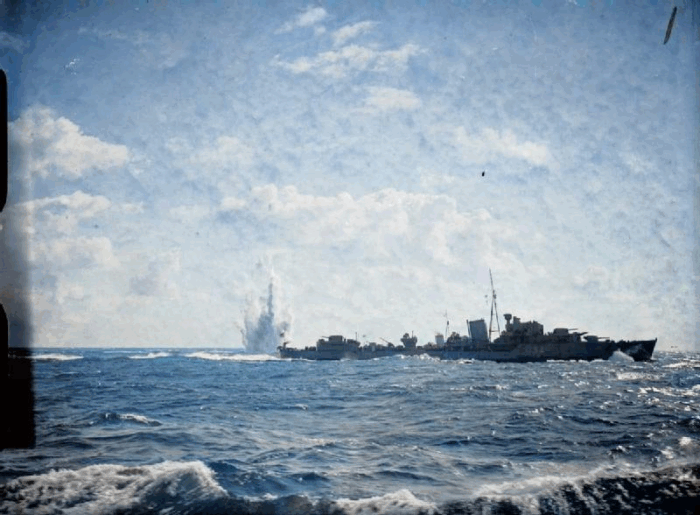
 HMS Jaguar William Denny & Brothers, Dumbarton was laid down on 25 November 1937 launched on 22 November 1938 and commissioned on 12 September 1939.
HMS Jaguar William Denny & Brothers, Dumbarton was laid down on 25 November 1937 launched on 22 November 1938 and commissioned on 12 September 1939.
In the early war she took part in patrols in the English Channel and the North Sea and participated in the evacuation operations of the Norwegian Campaign and Dunkirk evacuation (Operation Dynamo). Next she was sent to the Mediterranean, operating out of Malta. She took part in Operation Excess and other vital convoy escorts to Greece, Crete, and Egypt. She ws damaged in air attacks and repaired at Alexandria in 1942. She sank on 26 March 1942 when torpedoed by U-652 off Sidi Barrani. 193 crew members went down with her after her bow was cut and flooding was unstoppable.
 HMS Juno (ex-Jamaica) (1938)
HMS Juno (ex-Jamaica) (1938)
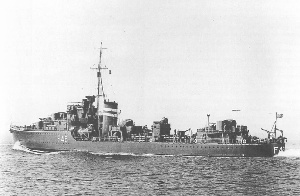 HMS Juno (ex-Jamaica) Fairfield Shipbuilding & Engineering Company, Govan was laid down on 15 October 1937 launched on 8 December 1938 and commissioned on 25 August 1939. Her original name was Jamaica, but it was attributed to a cruiser, so she was renamed before launch. In early service was on 1939–1940 she joined the 7th Destroyer Flotilla, Home Fleet. She conducted convoy escort, patrol, and ASW duties in British waters and western approaches. She took part in the Norwegian Campaign in April 1940, providing gunfire support and evacuating Allied troops in May.
HMS Juno (ex-Jamaica) Fairfield Shipbuilding & Engineering Company, Govan was laid down on 15 October 1937 launched on 8 December 1938 and commissioned on 25 August 1939. Her original name was Jamaica, but it was attributed to a cruiser, so she was renamed before launch. In early service was on 1939–1940 she joined the 7th Destroyer Flotilla, Home Fleet. She conducted convoy escort, patrol, and ASW duties in British waters and western approaches. She took part in the Norwegian Campaign in April 1940, providing gunfire support and evacuating Allied troops in May.
She was reassigned to the mediterranean Fleet early in 1941. She took part in the Battle of Crete, escorting convoys and supporting British efforts to defend the island from German invasion. She sank on 21 May 1941 while escorting convoy operations and supporting the defense of Crete, when attacked by German Ju 87 Stuka dive-bombers from Luftwaffe I./StG 2.
She was hit by multiple bombs, broke in two, and sank within minutes south of Crete, with 100 of her crew which went down with the ship. She became one of the first Royal Navy destroyers sunk during the Battle of Crete, showing how much the by Axis air power could pose in the mediterranean theater. Sehe underlined the urgent need for improved anti-aircraft capabilities on Royal Navy destroyers.
 HMS janus (1938)
HMS janus (1938)
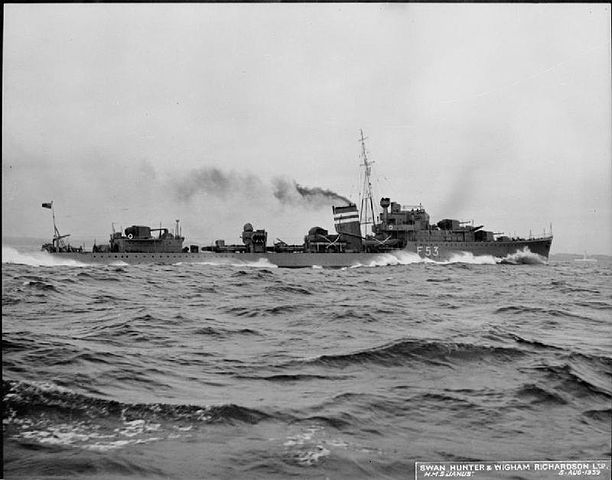
HMS Janus Swan Hunter & Wigham Richardson, Wallsend was laid down on 29 September 1937 launched on 11 October 1938 and commissioned on 5 August 1939. She took part in the North Sea & Mediterranean Operations on 1939–1941, assigned to the 7th Destroyer Flotilla, Home Fleet, operating mainly in the North Sea. She took part in convoy escort and anti-submarine patrols, but no the Norwegian campaign. She was transferred to the mediterranean fleet in 1940 and took part in the Battle of Calabria on july. Next she took part, after other escort missions, to the Battle of Cape Matapan on march 1941. She also took part in the Evacuation of Greece and Crete on april–may 1941. She took part in the Tobruk resupply runs and support for Malta convoys in 1942–1943 and then shore bombardments, notably with Operation Torch in November 1942 and North African campaign operations. She was in Escort and fire-support duties for Allied landings in Sicily (Operation Husky) in July 1943. She provided naval gunfire support during the Allied landings at Anzio (Operation Shingle) in january 1944.
She notably shelled German positions along the Italian coast. She was sank by German air attack off Anzio on 23 january 1944 by a glided glide bomb (Fritz X or Hs 293) from a German Do 217 of KG 100, Luftwaffe. She exploded and sank quickly, with the loss of 158 crew members, 80 survivors rescued by other Royal Navy vessels.
 HMS Javelin (ex-Kashmir) (1938)
HMS Javelin (ex-Kashmir) (1938)
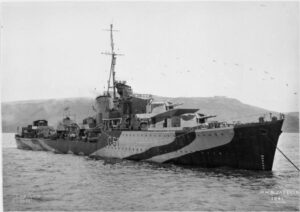 HMS Javelin (ex-Kashmir) John Brown & Company, Clydebank was laid down on 11 October 1937 launched on 21 December 1938 and commissioned on 10 June 1939. In the early War in 1939–1940
HMS Javelin (ex-Kashmir) John Brown & Company, Clydebank was laid down on 11 October 1937 launched on 21 December 1938 and commissioned on 10 June 1939. In the early War in 1939–1940
she was assigned to the 5th Destroyer Flotillan Home Fleet. She Conducted convoy escort, patrols, and supported minelaying operations in the North Sea and English Channel.
On 29 November 1940 During a night action off Plymouth against German destroyers from the 1st Torpedobootflottille, HMS Javelin was hit by torpedoes wit her bow and stern blown off and was left with only about 155 feet of hull from the original 339 feet. Despite catastrophic damage, her bulkhead held firm and amazingl she still could be towed back to port, miraculously she survived, but repairs were quite long and she only returned into service by mid-1942. She took part in later North Atlantic and Western Approaches escort duty and Channel patrols. In 1943 she partaked in the Mediterranean theater and Western Europe: First, she supported the Allied invasions of Sicily (Operation Husky) and landings in Italy. She joined Force K and Force H, taking part in convoy protection and bombardments. In 1944–1945 she took part in Normandy landings and subsequent coastal operations off France and the Netherlands. She escorted convoys and provided gunfire support against German shore installations and E-boat bases. After the war, HMS Javelin was placed in reserve. Deemed surplus to requirements in 1948 she was stricke, and broken up for scrap in 1949.
 HMS Jersey (1938)
HMS Jersey (1938)
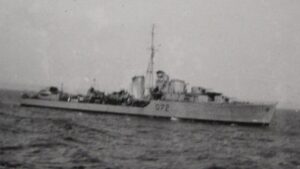 HMS Jersey J. Samuel White, Cowes was laid down on 20 September 1937 launched on 26 September 1938 and commissioned on 28 April 1939. Jersey worked up at Portland until July 1939. On 12 August she joined the 7th Destroyer Flotilla, Home Fleet, Scapa Flow. 7 December she was torpedoed off Haisborough Sands by Z12 Erich Giese, in solo chance patrol, while returning unseen from a minelaying mission. Ten of her company were killed but she survived. Jersey had her hull repaired at Henry Robb shipyard, Leith in a record 25 days. She needed however further fixes because her propeller was entangled in defence nets around the harbour. She was was back in action on 30 December.
HMS Jersey J. Samuel White, Cowes was laid down on 20 September 1937 launched on 26 September 1938 and commissioned on 28 April 1939. Jersey worked up at Portland until July 1939. On 12 August she joined the 7th Destroyer Flotilla, Home Fleet, Scapa Flow. 7 December she was torpedoed off Haisborough Sands by Z12 Erich Giese, in solo chance patrol, while returning unseen from a minelaying mission. Ten of her company were killed but she survived. Jersey had her hull repaired at Henry Robb shipyard, Leith in a record 25 days. She needed however further fixes because her propeller was entangled in defence nets around the harbour. She was was back in action on 30 December.
In 1940 she took on several escort mission, but too further damage in 1940, being towed to the Humber for repairs until 28 October 1940. Next she was sent to the Mediterranean theater.
On 2 May 1941 she struck an Italian aircraft-dropped mine off Malta’s Grand Harbour. She sank next to the Grand Harbour breakwater with 36 crew members going down with her.
She blocked the entrance to Malta’s Grand Harbour in fact, making all moves in and out of the harbour impossible for days. Kelly, Kelvin and Jackal were left trapped in the harbour until Jersey’s wreck was blasted by explosive and mostly cleared. On 5 May after further work, her wreck broke into two sections and allowed safer passage, but was only cleared out entirely postwar, after 1946 in a series of controlled demolitions between 1946 and 1949. Further salvage and clearance went on in 1968 in order to allow larger vessels to go through.
 HMS jupiter (1938)
HMS jupiter (1938)
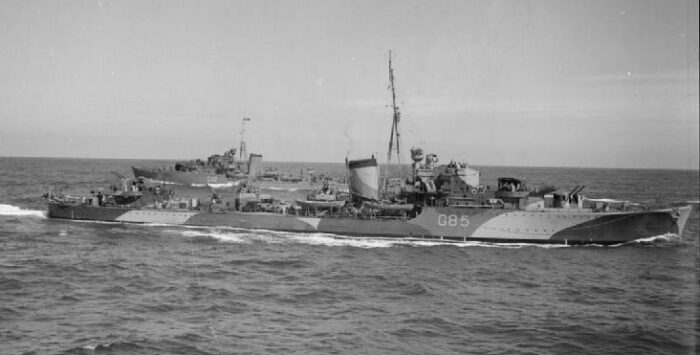
HMS Jupiter Yarrow & Company, Scotstoun was laid down on 28 September 1937 launched on 27 October 1938 and commissioned on 25 June 1939. After commissioning, sea trials and working up at Portland, she had her turbines repaired at Devonport, and only completed trials on 1 September 1939, the very day when the war started. She joined the 7th Destroyer Flotilla, Home Fleet, Humber, arrived the day of the declaration of war on 3 September 1939. On 29 November 1941, Jupiter and Encounter were detached from the Mediterranean Fleet and joined Force G at Colombo. They met with the battlecruiser Repulse at sea and sailed to Singapore, arrived on 2 December. After a few days on shore leave and refit, they were made ready for more orders. On 1 December Sir Tom (“thumb”) Phillips, a very popular officer, was announced to be promoted full Admiral, and appointed Commander-in-Chief of the Eastern Fleet. Next Repulse started her voyage to Australia with the destroyers Vampire and Tenedos until recalled. 9 days later, Tenedos and Repulsed joined Force Z to attack the Japanese invasion force. But both Repulse and Prince of Wales were caught by a properly massive air attack mostly made by two-engine G3M bombers. Jupiter escaped destruction by not being there and started her campaign in the Pacific, the only one of the J class to do so. Under command of Lieutenant Commander Norman V. J. T. Thew she sank the I-60 on 17 January 1942. On 27 February 1942 she struck an uncharted mine from the Dutch minelayer HNLMS Gouden Leeuw as part of the American-British-Dutch-Australian Command (ABDA) cruiser force. At the Battle of the Java Sea she sank off north Java coast at 21:16 hours. The initial detonation was believed to be a Japanese torpedo. 97 of the crew survivbed the sinking only to be picked up and captured by Japanese forces, while 83 luckier men were spotted and rescued from the shore by USS S-38. 84 went down with the ship. The wreck was later discovered pillaged and destoyed when surveyed, despite international treaties making her a war grave.
 HMS Kandahar (1939)
HMS Kandahar (1939)
HMS Kandahar William Denny & Brothers, Dumbarton was laid down on 18 January 1938 launched on 21 March 1939 and commissioned on 10 October 1939. Mined off Tripoli on 19 December 1941, and later scuttled.
Expanded on the next update.
 HMS Kashmir (1939)
HMS Kashmir (1939)
HMS Kashmir (ex-Javelin) Thornycroft, Woolston was laid down on 18 November 1937 launched on 4 April 1939 and commissioned on 26 October 1939. Bombed by German aircraft, 23 May 1941.
Expanded on the next update.
 HMS Kelvin (1939)
HMS Kelvin (1939)
HMS Kelvin Fairfield Shipbuilding, Govan was laid down on 5 October 1937 launched on 19 January 1939 and commissioned on 27 November 1939. Sold for scrap on 1949.
Expanded on the next update.
 HMS Khartoum (1939)
HMS Khartoum (1939)
HMS Khartoum Swan Hunter, Wallsend was laid down on 27 October 1937, launched on 6 February 1939 and commissioned on 6 November 1939. Sank in Perim Harbour after an exploding torpedo air vessel started a fire which reached the aft magazine, 23 June 1940.
Expanded on the next update.
 HMS Kimberley (1940)
HMS Kimberley (1940)
HMS Kimberley Thornycroft, Woolston was laid down on 17 January 1938 launched on 1 June 1939 and commissioned on 21 February 1940. Sold for scrap on 1949.
Expanded on the next update.
 HMS Kingston (1939)
HMS Kingston (1939)
HMS Kingston J. Samuel White, Cowes was laid down on 6 October 1937, launched on 9 January 1939 and commissioned on 14 September 1939. Seriously damaged by the Italian battleship Littorio during the Second Battle of Sirte, 22 March 1942. Bombed by German aircraft while in dry dock, 11 April 1942, and written off as a constructive total loss.
Expanded on the next update.
 HMS Kipling (1939)
HMS Kipling (1939)
Kipling Yarrow & Company, Scotstoun was laid down on 26 October 1937, launched 19 January 1939 and commissioned on 22 December 1939. Bombed and sunk by German aircraft off Mersa Matruh on 11 May 1942.
Expanded on the next update.
 HMS Noble (1941)
HMS Noble (1941)
HMS Noble Denny was laid down on 10 July 1939, launched on 17 April 1941 and commissioned on 20 February 1942. To the Netherlands as Van Galen 1942 and sold for scrap on 1957.
Expanded on the next update.
 HMS Nonpareil (1941)
HMS Nonpareil (1941)
HMS Nonpareil was laid down on 22 May 1940, launched on 25 June 1941, and commissioned on 30 October 1942. To Netherlands as Tjerk Hiddes 1942. To Indonesia as Gadjah Mada 1951 and sold for scrap on 1961.
Expanded on the next update.
 HMS Nestor (1941)
HMS Nestor (1941)
HMS Nestor was laid down on 9 July 1940, launched on 12 February 1941 Bombed by Italian aircraft on 15 June 1942, and scuttled.
Expanded on the next update.
 HMS Nizam (1940)
HMS Nizam (1940)
HMS Nizam John Brown was laid down on 27 July 1939, laucnhed on 4 July 1940 19, commisioned December 1940 and Sold for scrap on 1955.
Expanded on the next update.
 HMS Norman (1941)
HMS Norman (1941)
HMS Norman Thornycroft was laid down on 30 October 1940, launched on 29 September 1941, and Sold for scrap on 1958.
Expanded on the next update.
 HMS Nepal (ex-Norseman) (1941)
HMS Nepal (ex-Norseman) (1941)
HMS Nepal (ex-Norseman) was laid down on 9 September 1939, launched on 4 December 1941, and commissioned on 29 May 1942. Sold for scrap, 1955.
Expanded on the next update.
 HMS Nerissa (1940)
HMS Nerissa (1940)
HMS Nerissa John Brown was laid down on 26 July 1939, laucnhed on 7 May 1940, and commissioned on 12 February 1941 To Poland as Piorun 1940, returned as HMS Noble 1946, sold for scrap in 1955.
Expanded on the next update.
Read More/Src
Books
Colledge, J. J.; Warlow, Ben (2006) [1969]. Ships of the Royal Navy: The Complete Record of all Fighting Ships of the Royal Navy (Rev. ed.). London: Chatham Publishing.
Campbell, N. J. M. (1980). “Great Britain”. In Chesneau, Roger (ed.). Conway’s All the World’s Fighting Ships 1922–1946. New York: Mayflower Books.
English, John (2001). Afridi to Nizam: British Fleet Destroyers 1937–43. Gravesend, Kent: World Ship Society.
Friedman, Norman (2006). British Destroyers and Frigates, the Second World War and After. NIP
Haarr, Geirr H. (2010). The Battle for Norway: April–June 1940. Annapolis, Maryland: Naval Institute Press.
Haarr, Geirr H. (2009). The German Invasion of Norway, April 1940. Annapolis, Maryland: Naval Institute Press.
Hodges, Peter & Friedman, Norman (1979). Destroyer Weapons of World War 2. Greenwich: Conway Maritime Press.
Langtree, Christopher (2002). The Kelly’s: British J, K, and N Class Destroyers of World War II. NIP.
Lenton, H. T. (1998). British & Empire Warships of the Second World War. Annapolis, Maryland: NIP
March, Edgar J. (1966). British Destroyers: A History of Development, 1892–1953; Drawn by Admiralty Permission from Official Records. London: Seeley Service.
Rohwer, Jürgen (2005). Chronology of the War at Sea 1939–1945: The Naval History of World War Two (Third Revised ed.). NIP
Whitley, M. J. (1988). Destroyers of World War Two: An International Encyclopedia. NIP.
Links
on navypedia.org
en.wikipedia.org/ J-,_K-_and_N
https://commons.wikimedia.org/wiki/Category:J,_K_and_N_class_destroyer
Video
Model Kits
https://www.scalemates.com/fr/topics/topic.php?id=87246

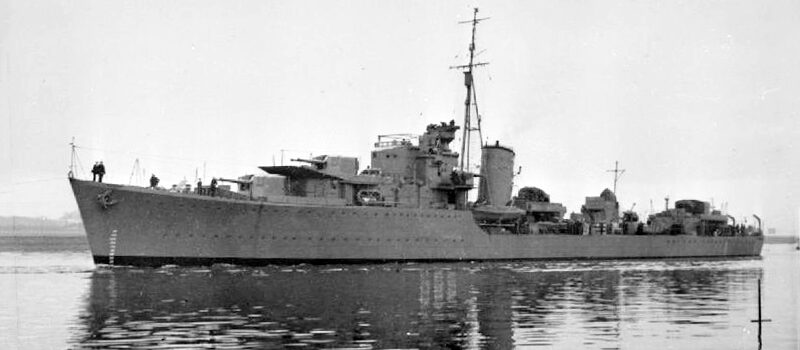
 Latest Facebook Entry -
Latest Facebook Entry -  X(Tweeter) Naval Encyclopedia's deck archive
X(Tweeter) Naval Encyclopedia's deck archive Instagram (@navalencyc)
Instagram (@navalencyc)


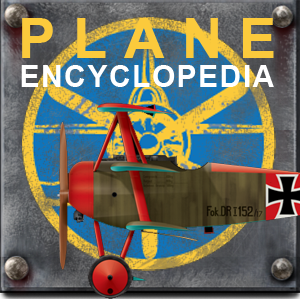
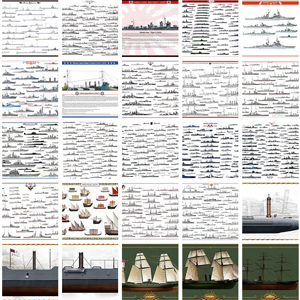

 French Navy
French Navy Royal Navy
Royal Navy Russian Navy
Russian Navy Armada Espanola
Armada Espanola Austrian Navy
Austrian Navy K.u.K. Kriegsmarine
K.u.K. Kriegsmarine Dansk Marine
Dansk Marine Nautiko Hellenon
Nautiko Hellenon Koninklije Marine 1870
Koninklije Marine 1870 Marinha do Brasil
Marinha do Brasil Osmanlı Donanması
Osmanlı Donanması Marina Do Peru
Marina Do Peru Marinha do Portugal
Marinha do Portugal Regia Marina 1870
Regia Marina 1870 Nihhon Kaigun 1870
Nihhon Kaigun 1870 Preußische Marine 1870
Preußische Marine 1870 Russkiy Flot 1870
Russkiy Flot 1870 Svenska marinen
Svenska marinen Søværnet
Søværnet Union Navy
Union Navy Confederate Navy
Confederate Navy Armada de Argentina
Armada de Argentina Imperial Chinese Navy
Imperial Chinese Navy Marinha do Portugal
Marinha do Portugal Mexico
Mexico Kaiserliche Marine
Kaiserliche Marine 1898 US Navy
1898 US Navy Sovietskiy Flot
Sovietskiy Flot Royal Canadian Navy
Royal Canadian Navy Royal Australian Navy
Royal Australian Navy RNZN Fleet
RNZN Fleet Chinese Navy 1937
Chinese Navy 1937 Kriegsmarine
Kriegsmarine Chilean Navy
Chilean Navy Danish Navy
Danish Navy Finnish Navy
Finnish Navy Hellenic Navy
Hellenic Navy Polish Navy
Polish Navy Romanian Navy
Romanian Navy Turkish Navy
Turkish Navy Royal Yugoslav Navy
Royal Yugoslav Navy Royal Thai Navy
Royal Thai Navy Minor Navies
Minor Navies Albania
Albania Austria
Austria Belgium
Belgium Columbia
Columbia Costa Rica
Costa Rica Cuba
Cuba Czechoslovakia
Czechoslovakia Dominican Republic
Dominican Republic Haiti
Haiti Hungary
Hungary Honduras
Honduras Estonia
Estonia Iceland
Iceland Eire
Eire Equador
Equador Iran
Iran Iraq
Iraq Latvia
Latvia Liberia
Liberia Lithuania
Lithuania Mandchukuo
Mandchukuo Morocco
Morocco Nicaragua
Nicaragua Persia
Persia San Salvador
San Salvador Sarawak
Sarawak Uruguay
Uruguay Venezuela
Venezuela Zanzibar
Zanzibar Warsaw Pact Navies
Warsaw Pact Navies Bulgaria
Bulgaria Hungary
Hungary

 Bundesmarine
Bundesmarine Dutch Navy
Dutch Navy Hellenic Navy
Hellenic Navy Marina Militare
Marina Militare Yugoslav Navy
Yugoslav Navy Chinese Navy
Chinese Navy Indian Navy
Indian Navy Indonesian Navy
Indonesian Navy JMSDF
JMSDF North Korean Navy
North Korean Navy Pakistani Navy
Pakistani Navy Philippines Navy
Philippines Navy ROKN
ROKN Rep. of Singapore Navy
Rep. of Singapore Navy Taiwanese Navy
Taiwanese Navy IDF Navy
IDF Navy Saudi Navy
Saudi Navy Royal New Zealand Navy
Royal New Zealand Navy Egyptian Navy
Egyptian Navy South African Navy
South African Navy






























 Ukrainian Navy
Ukrainian Navy dbodesign
dbodesign